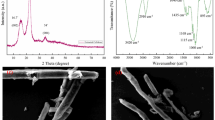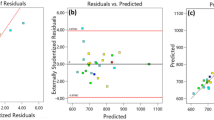Abstract
A novel type of three-dimensional network structure, covalent organic frameworks (COFs) aerogel, was fabricated and applied to dispersive solid-phase extraction (dSPE) of quinolone antibiotics (QAs). Density functional theory (DFT) was applied to investigate the possible interaction mechanism and results confirmed that the strong adsorption affinity is attributed to the intralayer hydrogen bonds and π-π interaction. Furthermore, a sensitive analytical method based on COFs-aerogel for determining quinolone antibiotics residues in water and honey samples was developed and HPLC-MS/MS was used for sample detection and quantification. Under the optimal conditions, COFs-aerogel exhibited a wide linearity (0.1–500 ng∙L−1), low limits of detection (0.02–0.06 ng∙L−1), and good precision (RSD ˂ 10%) for selected QAs. A preliminary practical application of the developed method was proved by the efficient detection of quinolone antibiotics in water and food samples with good recoveries (68.2–104% and 64.0–100% for water and honey samples, respectively). Combining the experimental data with theoretical calculation, results illustrated that COFs-aerogel holds a great potential to capture contaminants and address environmental and food safety issues.
Graphical abstract






Similar content being viewed by others
References
Zainab SM, Junaid M, Xu N, Malik RN (2020) Antibiotics and antibiotic resistant genes (ARGs) in ground water: a global review on dissemination, sources, interactions, environmental and human health risks. Water Res 187:116455. https://doi.org/10.1002/chem.201706056
Congilosi JL, Aga DS (2021) Review on the fate of antimicrobials, antimicrobial resistance genes, and other micropollutants in manure during enhanced anaerobic digestion and composting. J Hazard Mater 405:123634. https://doi.org/10.1016/j.jhazmat.2020.123634
Han Y, Ma YY, Yao SC, Zhang JP, Hu CQ (2021) In vivo and in silico evaluations of survival and cardiac developmental toxicity of quinolone antibiotics in zebrafish embryos (Danio rerio). Environ Pollut 277:116779. https://doi.org/10.1016/j.envpol.2021.116779
Wang JX, Lu XN, Jing QL, Zhang BW, Ye JH, Zhang HC, Xiao ZH, Zhang JE (2023) Spatiotemporal characterization of heavy metal and antibiotics in the Pearl River Basin and pollutants removal assessment using invasive species-derived biochars. J Hazard Mater 454:131409. https://doi.org/10.1016/j.jhazmat.2023.131409
Hong JW, Liu XM, Yang XY, Wang YS, Zhao LS (2022) Ionic liquid-based dispersive liquid-liquid microextraction followed by magnetic solid-phase extraction for determination of quinolones. Microchim Acta 189:8. https://doi.org/10.1007/s00604-021-05077-5
Xu GJ, Dong XF, Hou LF, Wang XL, Liu L, Ma H, Zhao RS (2020) Room-temperature synthesis of flower-shaped covalent organic frameworks for solid-phase extraction of quinolone antibiotics. Anal Chim Acta 1126:82–90. https://doi.org/10.1016/j.aca.2020.05.071
Sullivan MV, Henderson A, Hand RA, Turner NW (2022) A molecularly imprinted polymer nanoparticle-based surface plasmon resonance sensor platform for antibiotic detection in river water and milk. Anal Bioanal Chem 414:3687–3696. https://doi.org/10.1007/s00216-022-04012-8
Kojok HEI, Darra NEI, Khalil M, Capo A, Pennacchio A, Staiano M, Camarca A, D’Auria S, Varriale A (2020) Fluorescence polarization assay to detect the presence of traces of ciprofloxacin. Sci Rep 10:4550. https://doi.org/10.1038/s41598-020-61395-3
Zeng HP, Chen JH, Zhang CJ, Huang XA, Sun YM, Xu ZL, Lei HT (2016) Broad-specificity chemiluminescence enzyme immunoassay for (fluoro)quinolones: hapten design and molecular modeling study of antibody recognition. Anal Chem 88:3909–3916. https://doi.org/10.1021/acs.analchem.6b00082
Pochivalov A, Timofeeva I, Vakh C, Bulatov A (2017) Switchable hydrophilicity solvent membrane-based microextraction: HPLC-FLD determination of fluoroquinolones in shrimps. Anal Chim Acta 976:35–44. https://doi.org/10.1016/j.aca.2017.04.054
Locatelli M, Ciavarella MT, Paolino D, Celia C, Fiscarelli E, Ricciotti G, Pompilio A, Bonaventura GD, Grande Q, Zengin G, Marzio LD (2015) Determination of ciprofloxacin and levofloxacin in human sputum collected from cystic fibrosis patients using microextraction by packed sorbent-high performance liquid chromatography photodiode array detector. J Chromatogr A 1419:58–66. https://doi.org/10.1016/j.chroma.2015.09.075
Wang R, Chen DW, Zhao YF, Wu YN, Qi KM (2021) Selective extraction and enhanced-sensitivity detection of fluoroquinolones in swine body fluids by liquid chromatography-high resolution mass spectrometry: application in long-term monitoring in livestock. Food Chem 341:128269. https://doi.org/10.1016/j.foodchem.2020.128269
Zhang ZC, Cheng HF (2017) Recent development in sample preparation and analytical techniques for determination of quinolone residues in food products. Crit Rev Anal Chem 47:223–250. https://doi.org/10.1080/10408347.2016.1266924
Büyüktiryaki S, Keçili R, Hussain CM (2020) Functionalized nanomaterials in dispersive solid phase extraction: advances & prospects. TrAC-Trend Anal Chem 127:115893. https://doi.org/10.1016/j.trac.2020.115893
Ma JM, Lu L, Wang X, Chen LZ, Lin JM, Zhao RS (2019) Development of dispersive solid-phase extraction with polyphenylene conjugated microporous polymers for sensitive determination of phenoxycarboxylic acids in environmental water samples. J Hazard Mater 371:433–439. https://doi.org/10.1016/j.jhazmat.2019.03.033
Li J, Dong C, An WJ, Zhang YH, Zhao QY, Li ZX, Jiao BN (2020) Simultaneous enantioselective determination of two new isopropanol-triazole fungicides in plant-origin foods using multiwalled carbon nanotubes in reversed-dispersive solid-phase extraction and ultrahigh-performance liquid chromatography–tandem mass spectrometry. J Agric Food Chem 68:5969–5979. https://doi.org/10.1021/acs.jafc.0c01385
Manousi N, Gomez-Gomez B, Madrid Y, Deliyanni EA, Zachariadis GA (2020) Determination of rare earth elements by inductively coupled plasma-mass spectrometry after dispersive solid phase extraction with novel oxidized graphene oxide and optimization with response surface methodology and central composite design. Microchem J 152:104428. https://doi.org/10.1016/j.microc.2019.104428
Li JM, Zhou YQ, Sun ZA, Cai TP, Wang XX, Zhao SW, Liu HC, Gong BL (2020) Restricted access media-imprinted nanomaterials based on a metal-organic framework for highly selective extraction of fluoroquinolones in milk and river water. J Chromatogr A 1626:461364. https://doi.org/10.1016/j.chroma.2020.461364
Zafar MN, Dar Q, Nawaz F, Zafar MN, Iqbal M, Nazar MF (2019) Effective adsorptive removal of azo dyes over spherical ZnO nanoparticles. J Mater Res Technol 8:713–725. https://doi.org/10.1016/j.jmrt.2018.06.002
Niu ZL, Sun YQ, Wang ZC, Wen YY (2022) Self-synthesized TiO2 nanoparticels-pH-mediated dispersive solid-phase extraction coupled with high performance liquid chromatography for the determination of quinolones in biological matrices. J Environ Sci Heal A 57:656–666. https://doi.org/10.1080/10934529.2022.2101340
Zhu DY, Xu GY, Barnes M, Li YL, Tseng CP, Zhang ZQ, Zhang JJ, Zhu YF, Khalil S, Rahman MM, Verduzco R, Ajayan PM (2021) Covalent organic frameworks for batteries. Adv Funct Mater 31:2100505. https://doi.org/10.1002/adfm.202100505
Xiong YF, Liao QB, Huang ZP, Huang X, Ke C, Zhu HT, Dong CY, Wang HS, Xi K, Zhan P, Xu F, Lu YQ (2020) Ultrahigh responsivity photodetectors of 2D covalent organic frameworks integrated on graphene. Adv Mater 32:1907242. https://doi.org/10.1002/adma.201907242
Sharma RK, Yadav P, Yadav M, Gupta R, Rana P, Srivastava A, Zbořil R, Varma RS, Antonietti M, Gawande MB (2020) Recent development of covalent organic frameworks (COFs): synthesis and catalytic (organic-electro-photo) application. Mater Horiz 7:411–454. https://doi.org/10.1039/C9MH00856J
Wang LY, Xu H, Gao JK, Yao TM, Zhang QC (2019) Recent progress in metal-organic frameworks-based hydrogels and aerogels and their applications. Coord Chem Rev 398:213016. https://doi.org/10.1016/j.ccr.2019.213016
Peydayesh M, Suter MK, Bolisetty S, Boulos S, Handschin S, Nyström L, Mezzenga R (2020) Amyloid fibrils aerogel for sustainable removal of organic contaminants from water. Adv Mater 32:1907932. https://doi.org/10.1002/adma.201907932
Chen ZH, Zhao H, Hu YJ, Lai HH, Liu LX, Zhong LX, Peng XW (2020) Wood-derived lightweight and elastic carbon aerogel for pressure sensing and energy storage. Adv Funct Mater 30:1910292. https://doi.org/10.1002/adfm.201910292
Li CX, Yang J, Pachfule P, Li S, Ye MY, Schmidt J, Thomas A (2020) Ultralight covalent organic framework/graphene aerogel with hierarchical porosity. Nat Commun 11:4712. https://doi.org/10.1038/s41467-020-18427-3
Zhu DY, Zhu YF, Yan QQ, Barnes M, Liu FX, Yu PF, Tseng CP, Tjahjono N, Huang PC, Rahman MM, Egap E, Ajayan PM, Verduzco R (2021) Pure crystalline covalent organic framework aerogel. Chem Mater 33:4216–4224. https://doi.org/10.1021/acs.chemmater.1c01122
Zhang ZP, Shi XS, Wang XY, Zhang Z, Wang Y (2023) Encaosulating covalent organic frameworks (COFs) in cellulose aerogels for efficient iodine uptake. Sep Purif Technol 209:123108. https://doi.org/10.1016/j.seppur.2023.123108
Liu ZC, Liu Y, Li JS, Zhu WH (2017) Prediction of supramolecular synthons and crystal packing of supramolecular HMX/solvent assemblies. RSC Adv 7:55482–55488. https://doi.org/10.1039/C7RA10043D
Li QL, Guo SF, Zhang Y, Wo R, Zhao RS, Jiang W (2020) Silver-organic coordination networks for magnetic solid-phase extraction of trihalomethanes from environmental water samples: experimental and theoretical calculation study. J Hazard Mater 396:122741. https://doi.org/10.1016/j.jhazmat.2020.122741
McKinnon JJ, Jayatilaka D, Spackman MA (2007) Towards quantitative analysis of intermolecular interactions with Hirshfeld surfaces. Chem Commun 37:3814–3816. https://doi.org/10.1039/B704980C
Saremi F, Miroliaei MR, Nejad MS, Sheibani H (2022) Adsorption of tetracycline antibiotic from aqueous solutions onto vitamin B6-upgraded biochar derived from date palm leaves. J Mol Liq 318:114126. https://doi.org/10.1016/j.molliq.2020.114126
Deng JW, Yu TT, Yao Y, Peng Q, Luo LJ, Chem BW, Wang XW, Yang YY, Luan TG (2017) Surface-coated wooden-tip electrospray ionization mass spectrometry for determination of trace fluoroquinolone and macrolide antibiotics in water. Anal Chim Acta 954:52–59. https://doi.org/10.1016/j.aca.2016.12.008
Zhao YJ, Li WH, Liu JM, Huang K, Wu CD, Shao HQ, Chen HY, Liu XT (2017) Modification of garlic peel by nitric acid and its application as a novel adsorbent for solid-phase extraction of quinolone antibiotics. Chem Eng J 326:745–755. https://doi.org/10.1016/j.cej.2017.05.139
Cui XQ, Zhang PJ, Yang XL, Yang MY, Zhou WF, Zhang SB, Gao HX, Lu RH (2015) β-CD/ATP composite materials for use in dispersive solid-phase extraction to measure (fluoro)quinolone antibiotics in honey samples. Anal Chim Acta 878:131–139. https://doi.org/10.1016/j.aca.2015.03.056
Pang JL, Liao YM, Huang XJ, Ye Z, Yuan DX (2019) Metal-organic framework-monolith composite-based in-tube solid phase microextraction on-line coupled to high-performance liquid chromatography-fluorescence detection for the highly sensitive monitoring of fluoroquinolones in water and food samples. Talanta 99:499–506. https://doi.org/10.1016/j.talanta.2019.03.019
Englert B, U.S. EPA. Method 1694: Pharmaceuticals and personal care products in water, soil, sediment, and biosolids by HPLC/MS/MS, 2007b, EPA821-R-08-002
Funding
This work is supported by the National Key Research and Development Program of China (2021YFA0910403), National Natural Science Foundation of China (No. 21972102), Jiangsu Laboratory for Biochemical Sensing and Biochip, and Jiangsu Key Laboratory for Micro and Nano Heat Fluid Flow Technology and Energy Application, Natural Science Foundation of Suzhou University of Science and Technology (No. 332114410).
Author information
Authors and Affiliations
Corresponding authors
Ethics declarations
Conflict of interest
The authors declare no competing interests.
Additional information
Publisher’s note
Springer Nature remains neutral with regard to jurisdictional claims in published maps and institutional affiliations.
Supplementary information
ESM 1
Table S1 LC-MS/MS MRM data acquisition method. Table S2 Experimental domain and response surface design matrix for the optimization of the extraction step. Table S3 Parameters of kinetics. Table S4 Parameters of analytical performances. Figure S1 Nitrogen sorption isotherm profile of COFs-aerogel. Figure S2 (A) XPS survey spectrum of the surface of TAPB-DMTP-COFs; (B) XPS spectrum of the O 1s on the TAPB-DMTP-COFs. Figure S3 Response surfaces by BBD for the recovery based on a plot of adsorbent mass versus pH. Figure S4 (A) Typical chromatograms of selected analytes in the surface water sample and spiked sample with 100 ng/L; (B) Cyclic adsorption capacities of COFs-aerogel for the adsorption of QAs. Figure S5 The storage life time of COFs-aerogel (DOCX 2842 kb)
Rights and permissions
Springer Nature or its licensor (e.g. a society or other partner) holds exclusive rights to this article under a publishing agreement with the author(s) or other rightsholder(s); author self-archiving of the accepted manuscript version of this article is solely governed by the terms of such publishing agreement and applicable law.
About this article
Cite this article
Li, Q., Zhu, S., Wu, F. et al. Slice-layer COFs-aerogel: a regenerative dispersive solid-phase extraction adsorbent for determination of ultra-trace quinolone antibiotics. Microchim Acta 190, 369 (2023). https://doi.org/10.1007/s00604-023-05925-6
Received:
Accepted:
Published:
DOI: https://doi.org/10.1007/s00604-023-05925-6




